Hongxu Chen
Policy Mirror Descent with Temporal Difference Learning: Sample Complexity under Online Markov Data
Dec 30, 2025Abstract:This paper studies the policy mirror descent (PMD) method, which is a general policy optimization framework in reinforcement learning and can cover a wide range of policy gradient methods by specifying difference mirror maps. Existing sample complexity analysis for policy mirror descent either focuses on the generative sampling model, or the Markovian sampling model but with the action values being explicitly approximated to certain pre-specified accuracy. In contrast, we consider the sample complexity of policy mirror descent with temporal difference (TD) learning under the Markovian sampling model. Two algorithms called Expected TD-PMD and Approximate TD-PMD have been presented, which are off-policy and mixed policy algorithms respectively. Under a small enough constant policy update step size, the $\tilde{O}(\varepsilon^{-2})$ (a logarithm factor about $\varepsilon$ is hidden in $\tilde{O}(\cdot)$) sample complexity can be established for them to achieve average-time $\varepsilon$-optimality. The sample complexity is further improved to $O(\varepsilon^{-2})$ (without the hidden logarithm factor) to achieve the last-iterate $\varepsilon$-optimality based on adaptive policy update step sizes.
MobileMamba: Lightweight Multi-Receptive Visual Mamba Network
Nov 24, 2024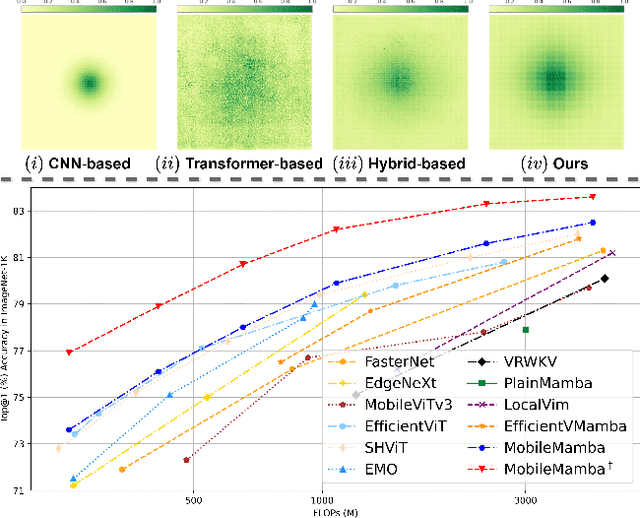
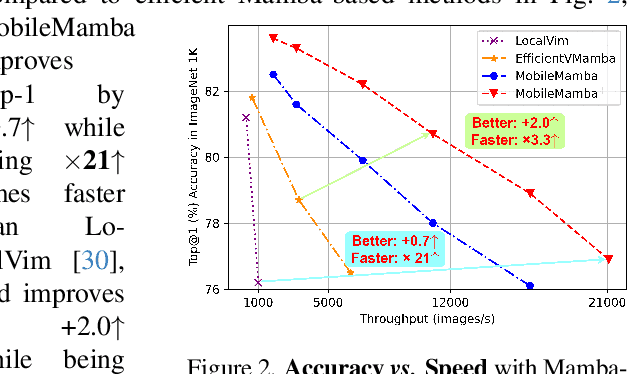

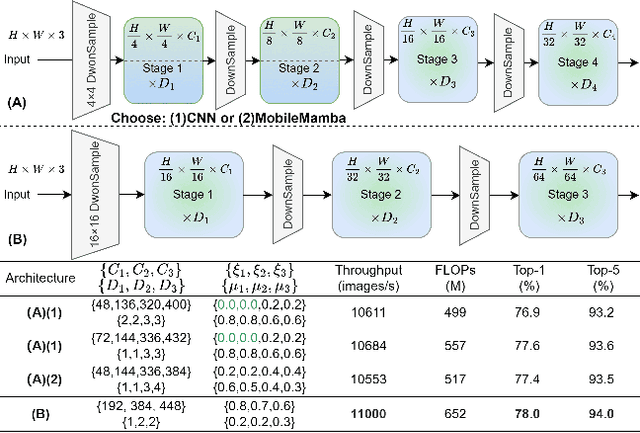
Abstract:Previous research on lightweight models has primarily focused on CNNs and Transformer-based designs. CNNs, with their local receptive fields, struggle to capture long-range dependencies, while Transformers, despite their global modeling capabilities, are limited by quadratic computational complexity in high-resolution scenarios. Recently, state-space models have gained popularity in the visual domain due to their linear computational complexity. Despite their low FLOPs, current lightweight Mamba-based models exhibit suboptimal throughput. In this work, we propose the MobileMamba framework, which balances efficiency and performance. We design a three-stage network to enhance inference speed significantly. At a fine-grained level, we introduce the Multi-Receptive Field Feature Interaction(MRFFI) module, comprising the Long-Range Wavelet Transform-Enhanced Mamba(WTE-Mamba), Efficient Multi-Kernel Depthwise Convolution(MK-DeConv), and Eliminate Redundant Identity components. This module integrates multi-receptive field information and enhances high-frequency detail extraction. Additionally, we employ training and testing strategies to further improve performance and efficiency. MobileMamba achieves up to 83.6% on Top-1, surpassing existing state-of-the-art methods which is maximum x21 faster than LocalVim on GPU. Extensive experiments on high-resolution downstream tasks demonstrate that MobileMamba surpasses current efficient models, achieving an optimal balance between speed and accuracy.
IterIS: Iterative Inference-Solving Alignment for LoRA Merging
Nov 21, 2024



Abstract:Low-rank adaptations (LoRA) are widely used to fine-tune large models across various domains for specific downstream tasks. While task-specific LoRAs are often available, concerns about data privacy and intellectual property can restrict access to training data, limiting the acquisition of a multi-task model through gradient-based training. In response, LoRA merging presents an effective solution by combining multiple LoRAs into a unified adapter while maintaining data privacy. Prior works on LoRA merging primarily frame it as an optimization problem, yet these approaches face several limitations, including the rough assumption about input features utilized in optimization, massive sample requirements, and the unbalanced optimization objective. These limitations can significantly degrade performance. To address these, we propose a novel optimization-based method, named IterIS: 1) We formulate LoRA merging as an advanced optimization problem to mitigate the rough assumption. Additionally, we employ an iterative inference-solving framework in our algorithm. It can progressively refine the optimization objective for improved performance. 2) We introduce an efficient regularization term to reduce the need for massive sample requirements (requiring only 1-5% of the unlabeled samples compared to prior methods). 3) We utilize adaptive weights in the optimization objective to mitigate potential unbalances in LoRA merging process. Our method demonstrates significant improvements over multiple baselines and state-of-the-art methods in composing tasks for text-to-image diffusion, vision-language models, and large language models. Furthermore, our layer-wise algorithm can achieve convergence with minimal steps, ensuring efficiency in both memory and computation.
Data Watermarking for Sequential Recommender Systems
Nov 20, 2024



Abstract:In the era of large foundation models, data has become a crucial component for building high-performance AI systems. As the demand for high-quality and large-scale data continues to rise, data copyright protection is attracting increasing attention. In this work, we explore the problem of data watermarking for sequential recommender systems, where a watermark is embedded into the target dataset and can be detected in models trained on that dataset. We address two specific challenges: dataset watermarking, which protects the ownership of the entire dataset, and user watermarking, which safeguards the data of individual users. We systematically define these problems and present a method named DWRS to address them. Our approach involves randomly selecting unpopular items to create a watermark sequence, which is then inserted into normal users' interaction sequences. Extensive experiments on five representative sequential recommendation models and three benchmark datasets demonstrate the effectiveness of DWRS in protecting data copyright while preserving model utility.
Graph and Sequential Neural Networks in Session-based Recommendation: A Survey
Aug 27, 2024Abstract:Recent years have witnessed the remarkable success of recommendation systems (RSs) in alleviating the information overload problem. As a new paradigm of RSs, session-based recommendation (SR) specializes in users' short-term preference capture and aims to provide a more dynamic and timely recommendation based on the ongoing interacted actions. In this survey, we will give a comprehensive overview of the recent works on SR. First, we clarify the definitions of various SR tasks and introduce the characteristics of session-based recommendation against other recommendation tasks. Then, we summarize the existing methods in two categories: sequential neural network based methods and graph neural network (GNN) based methods. The standard frameworks and technical are also introduced. Finally, we discuss the challenges of SR and new research directions in this area.
MambaAD: Exploring State Space Models for Multi-class Unsupervised Anomaly Detection
Apr 14, 2024



Abstract:Recent advancements in anomaly detection have seen the efficacy of CNN- and transformer-based approaches. However, CNNs struggle with long-range dependencies, while transformers are burdened by quadratic computational complexity. Mamba-based models, with their superior long-range modeling and linear efficiency, have garnered substantial attention. This study pioneers the application of Mamba to multi-class unsupervised anomaly detection, presenting MambaAD, which consists of a pre-trained encoder and a Mamba decoder featuring (Locality-Enhanced State Space) LSS modules at multi-scales. The proposed LSS module, integrating parallel cascaded (Hybrid State Space) HSS blocks and multi-kernel convolutions operations, effectively captures both long-range and local information. The HSS block, utilizing (Hybrid Scanning) HS encoders, encodes feature maps into five scanning methods and eight directions, thereby strengthening global connections through the (State Space Model) SSM. The use of Hilbert scanning and eight directions significantly improves feature sequence modeling. Comprehensive experiments on six diverse anomaly detection datasets and seven metrics demonstrate state-of-the-art performance, substantiating the method's effectiveness.
Attention Is Not the Only Choice: Counterfactual Reasoning for Path-Based Explainable Recommendation
Jan 11, 2024Abstract:Compared with only pursuing recommendation accuracy, the explainability of a recommendation model has drawn more attention in recent years. Many graph-based recommendations resort to informative paths with the attention mechanism for the explanation. Unfortunately, these attention weights are intentionally designed for model accuracy but not explainability. Recently, some researchers have started to question attention-based explainability because the attention weights are unstable for different reproductions, and they may not always align with human intuition. Inspired by the counterfactual reasoning from causality learning theory, we propose a novel explainable framework targeting path-based recommendations, wherein the explainable weights of paths are learned to replace attention weights. Specifically, we design two counterfactual reasoning algorithms from both path representation and path topological structure perspectives. Moreover, unlike traditional case studies, we also propose a package of explainability evaluation solutions with both qualitative and quantitative methods. We conduct extensive experiments on three real-world datasets, the results of which further demonstrate the effectiveness and reliability of our method.
DiAD: A Diffusion-based Framework for Multi-class Anomaly Detection
Dec 11, 2023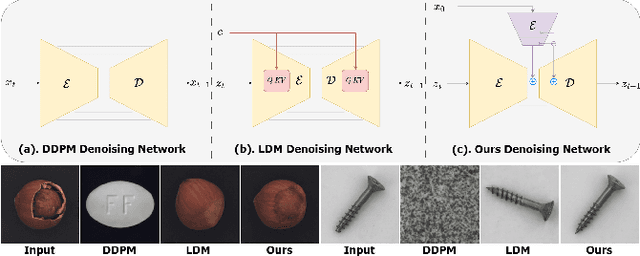
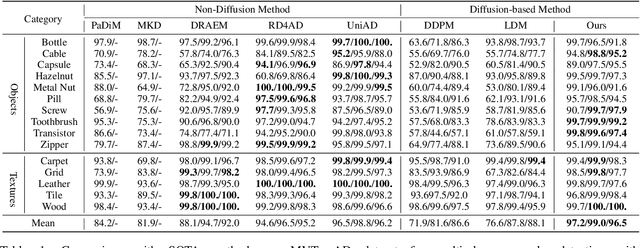
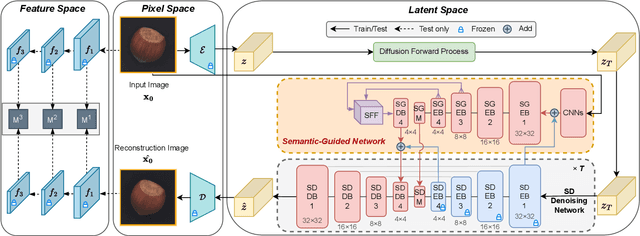
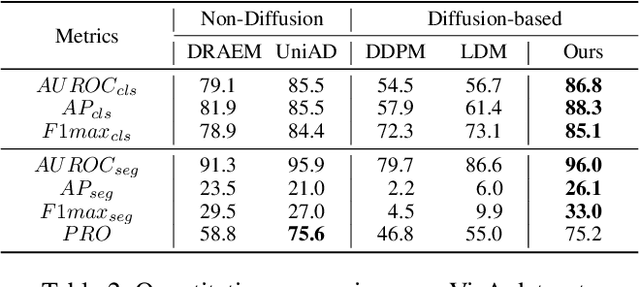
Abstract:Reconstruction-based approaches have achieved remarkable outcomes in anomaly detection. The exceptional image reconstruction capabilities of recently popular diffusion models have sparked research efforts to utilize them for enhanced reconstruction of anomalous images. Nonetheless, these methods might face challenges related to the preservation of image categories and pixel-wise structural integrity in the more practical multi-class setting. To solve the above problems, we propose a Difusion-based Anomaly Detection (DiAD) framework for multi-class anomaly detection, which consists of a pixel-space autoencoder, a latent-space Semantic-Guided (SG) network with a connection to the stable diffusion's denoising network, and a feature-space pre-trained feature extractor. Firstly, The SG network is proposed for reconstructing anomalous regions while preserving the original image's semantic information. Secondly, we introduce Spatial-aware Feature Fusion (SFF) block to maximize reconstruction accuracy when dealing with extensively reconstructed areas. Thirdly, the input and reconstructed images are processed by a pre-trained feature extractor to generate anomaly maps based on features extracted at different scales. Experiments on MVTec-AD and VisA datasets demonstrate the effectiveness of our approach which surpasses the state-of-the-art methods, e.g., achieving 96.8/52.6 and 97.2/99.0 (AUROC/AP) for localization and detection respectively on multi-class MVTec-AD dataset. Code will be available at https://lewandofskee.github.io/projects/diad.
Defense Against Model Extraction Attacks on Recommender Systems
Oct 25, 2023



Abstract:The robustness of recommender systems has become a prominent topic within the research community. Numerous adversarial attacks have been proposed, but most of them rely on extensive prior knowledge, such as all the white-box attacks or most of the black-box attacks which assume that certain external knowledge is available. Among these attacks, the model extraction attack stands out as a promising and practical method, involving training a surrogate model by repeatedly querying the target model. However, there is a significant gap in the existing literature when it comes to defending against model extraction attacks on recommender systems. In this paper, we introduce Gradient-based Ranking Optimization (GRO), which is the first defense strategy designed to counter such attacks. We formalize the defense as an optimization problem, aiming to minimize the loss of the protected target model while maximizing the loss of the attacker's surrogate model. Since top-k ranking lists are non-differentiable, we transform them into swap matrices which are instead differentiable. These swap matrices serve as input to a student model that emulates the surrogate model's behavior. By back-propagating the loss of the student model, we obtain gradients for the swap matrices. These gradients are used to compute a swap loss, which maximizes the loss of the student model. We conducted experiments on three benchmark datasets to evaluate the performance of GRO, and the results demonstrate its superior effectiveness in defending against model extraction attacks.
Federated Graph Contrastive Learning
Jul 24, 2022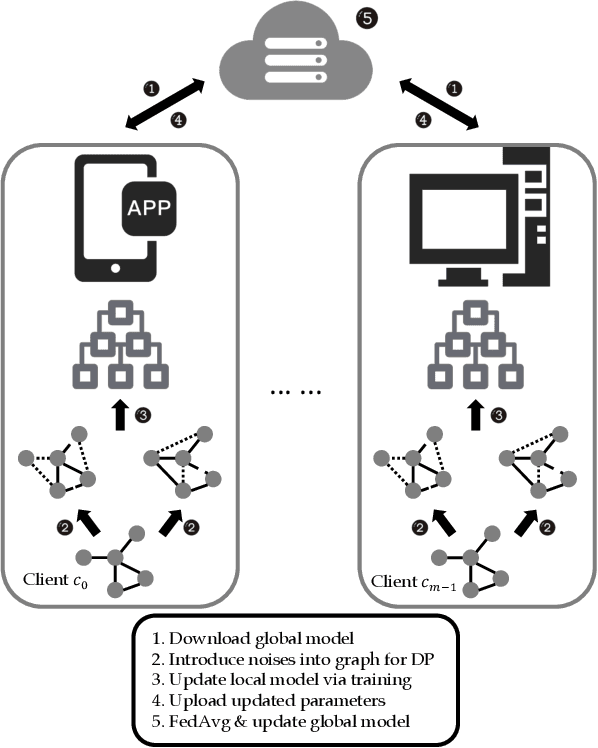
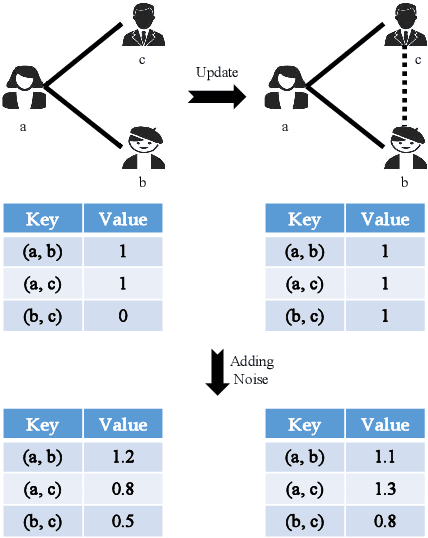
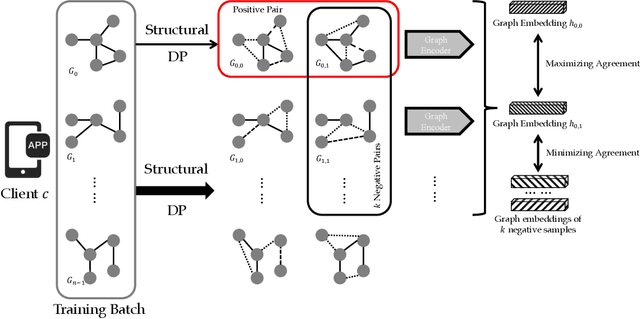
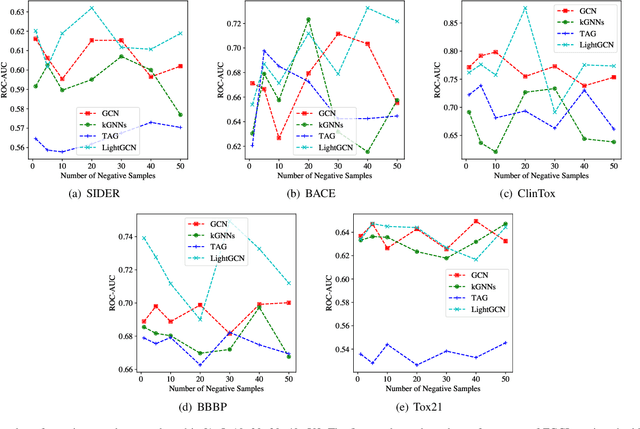
Abstract:Graph learning models are critical tools for researchers to explore graph-structured data. To train a capable graph learning model, a conventional method uses sufficient training data to train a graph model on a single device. However, it is prohibitive to do so in real-world scenarios due to privacy concerns. Federated learning provides a feasible solution to address such limitations via introducing various privacy-preserving mechanisms, such as differential privacy on graph edges. Nevertheless, differential privacy in federated graph learning secures the classified information maintained in graphs. It degrades the performances of the graph learning models. In this paper, we investigate how to implement differential privacy on graph edges and observe the performances decreasing in the experiments. We also note that the differential privacy on graph edges introduces noises to perturb graph proximity, which is one of the graph augmentations in graph contrastive learning. Inspired by that, we propose to leverage the advantages of graph contrastive learning to alleviate the performance dropping caused by differential privacy. Extensive experiments are conducted with several representative graph models and widely-used datasets, showing that contrastive learning indeed alleviates the models' performance dropping caused by differential privacy.
 Add to Chrome
Add to Chrome Add to Firefox
Add to Firefox Add to Edge
Add to Edge